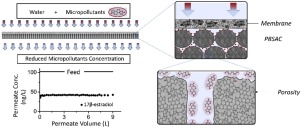Journal of Hazardous Materials ( IF 12.2 ) Pub Date : 2018-03-20 , DOI: 10.1016/j.jhazmat.2018.03.032 Matteo Tagliavini , Andrea I. Schäfer

|
Effective micropollutant removal requires energy intensive advanced treatment processes. A novel hybrid membrane configuration – consisting of both ultrafiltration (UF) and nanofiltration (NF) – with permeate-side polymer-based activated carbon (PBSAC) was developed and investigated for the removal of natural hormones with a particular focus on estradiol (E2). The UF-PBSAC process offers significantly enhanced water permeability and hence energy efficiency, while NF-PBSAC was anticipated to reduce residual micropollutant concentration. Realistic micropollutant concentration in the feed (100 ngL-1) can be reduced to 20-40 ngL-1 via adsorption in a thin layer (2.2 mm) of UF-PBSAC at a flux of 120-130 Lm-2 h−1. Furthermore, during the filtration of 9 L (membrane area 38 cm2), the micropollutant concentration was constant and no saturation could be achieved. Hormone removal was shown to further increase both at lower pressure (and hence flux) and thicker PBSAC layer (until 11 mm). In both cases, this effect was correlated to the increased contact time between estradiol and the PBSAC adsorbent. NF coupled with a PBSAC layer of 2.2 mm achieved a higher overall removal than the UF-PBSAC due to the intrinsic retention of NF. However, the residual NF permeate concentration was similar with and without PBSAC. Thus, the retention of hormones by NF and the adsorption inside the PBSAC layer were demonstrated to be two dependent processes. Overall, the combination of UF with PBSAC absorbent layers is a promising approach for the efficient removal of micropollutants.
中文翻译:

聚合物基球形活性炭(PBSAC)辅助膜过滤去除类固醇微污染物
有效的微污染物去除需要耗能的高级处理过程。开发了一种新型的混合膜结构-由超滤(UF)和纳滤(NF)组成-与渗透侧基于聚合物的活性炭(PBSAC)结合在一起,并研究了去除天然激素的方法,特别侧重于雌二醇(E2) 。UF-PBSAC工艺可显着提高水的渗透性,从而提高能源效率,而NF-PBSAC有望降低残留的微污染物浓度。进料(100 NGL在现实的微量污染物浓度-1)可以降低到20-40 NGL -1通过吸附在UF-PBSAC的薄层(2.2 MM)在120-130 Lm的磁通-2 ħ -1。此外,在过滤9 L(膜面积38 cm 2),微污染物的浓度是恒定的,无法达到饱和。结果表明,在较低的压力下(因而在通量下)和较厚的PBSAC层(至11毫米),去除激素的作用会进一步增加。在这两种情况下,这种影响都与雌二醇和PBSAC吸附剂之间增加的接触时间有关。由于NF的固有保留,与UF-PBSAC结合的NF与2.2 mm的PBSAC层相比,可实现更高的整体去除率。但是,在有和没有PBSAC的情况下,残留的NF渗透物浓度相似。因此,NF保留的激素和PBSAC层内部的吸附被证明是两个依赖的过程。总体而言,UF与PBSAC吸收层的结合是有效去除微量污染物的一种有前途的方法。











































 京公网安备 11010802027423号
京公网安备 11010802027423号